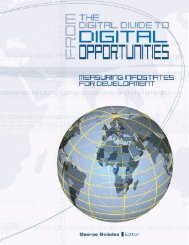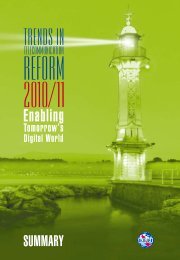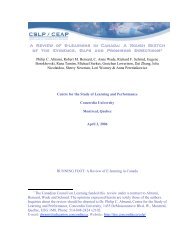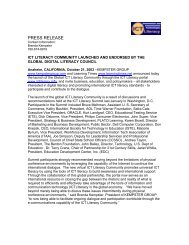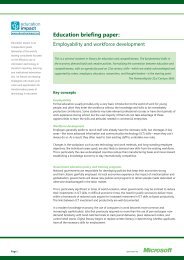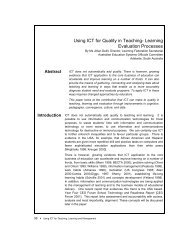147 pages pdf - ICT Digital Literacy
147 pages pdf - ICT Digital Literacy
147 pages pdf - ICT Digital Literacy
You also want an ePaper? Increase the reach of your titles
YUMPU automatically turns print PDFs into web optimized ePapers that Google loves.
Content, Content (Not To Mention Content) … How To Best Design & Deliver It<br />
#260: Know Your Learner, Give Them Choice<br />
Research learners' needs and attitudes in advance as much as possible, don't assume that "one size fits all." Design in<br />
bite-sized chunks that can be "driven by the learner". Build in interactivity (and no, pressing the "next" button doesn't count<br />
as interactivity!. Allow learners choice - choice of media, learning styles, and levels of learning. And build in fun!<br />
Ana Karakusevic<br />
BBC Training and Development<br />
#261: Design Learning Like Magazines<br />
Linear learning, while necessary in a standup classroom environment, needs to be avoided if at all possible<br />
in e-Learning. Consider the different ways individuals read a magazine. Some start reading at the front,<br />
some at the back, some in the middle. If they get into something they don't understand because they<br />
skipped around, they can go to the section which contains the information.<br />
Nancy Heiser<br />
Kimberly-Clark<br />
#262: Anticipate The Questions<br />
When using tools to create what is commonly known as "multimedia", try to get the person/character/whatever to<br />
ask the questions you always get in the real classroom environment. And of course supply the answer.<br />
Christer Carlsson<br />
LYSNNA & NJUT AB<br />
#263: Clear Expectations = No Surprises<br />
Always design your training to the lowest common denominator of your students. This applies to the technology<br />
they are able to access, the level of skill they possess and the ability they have. Make your expectations clear at<br />
the beginning, so that there are no surprises, and set the standard for the technology they will be required to have<br />
access to as well, so that if they are unable to get it, or use it, they will at least be aware that they need it. A course<br />
that I am taking used an assumption that everyone would be able to download freebies from the Internet. I'm doing<br />
the course from a work machine, as it relates to my job, but our firewall is so strict, that we are unable to download<br />
anything. Therefore, I am missing some audio pieces, and some animations. I was also unable to complete part<br />
of an assignment around building an animation. But there was no mention of needing the capability to do this or to<br />
be able to download in the course description.<br />
Peri Ziprick<br />
TransAlta Corporation<br />
#264: ENHANCE RETENTION Of Text Reading<br />
In course content text, many people already "bold" or "capitalize" the KEY WORDS or phrases. To<br />
IMPROVE RETENTION, however, what we do sometimes is to REPEAT these key words at the BOTTOM<br />
OF THE PAGE just before the "next page" button. It's quick, easy, and we have found it to be an effective<br />
method of driving key points into the reader's head.<br />
Geoff Falconar<br />
AEROSTUDIES Inc.<br />
#265: Turn Up The Volume<br />
Make your learning come alive - ramp up the engagement to make it game-like!<br />
Clark Quinn<br />
OtterSurf Laboratories<br />
#266: Don't Get Carried Away - Use Appropriate Examples<br />
Create a context for the learning by anchoring it in a real-world environment. Use authentic activities -<br />
don't create a bingo game for sales training.<br />
Phil Antonelli<br />
Intellinex<br />
701 e-Learning Tips by The MASIE Center www.masie.com 53





